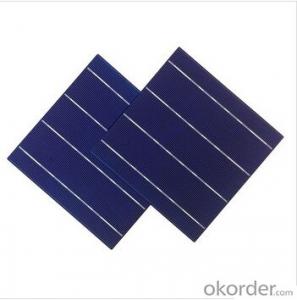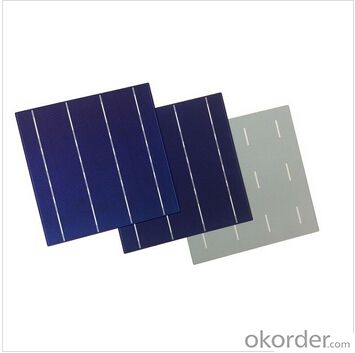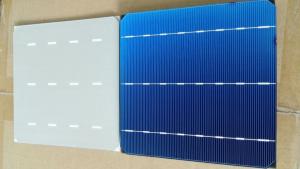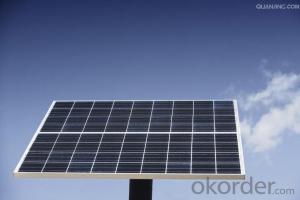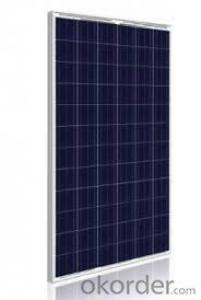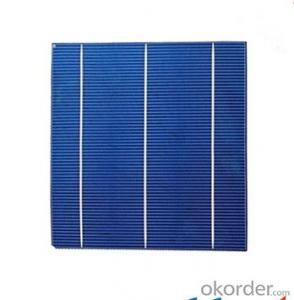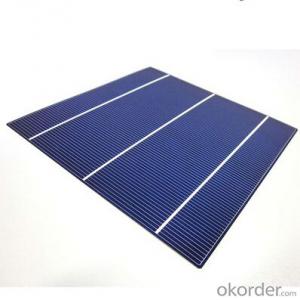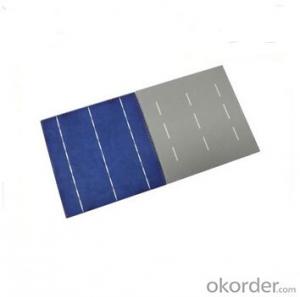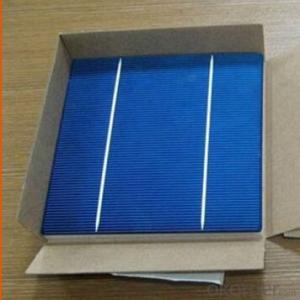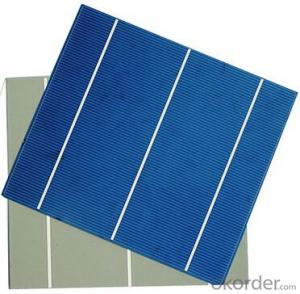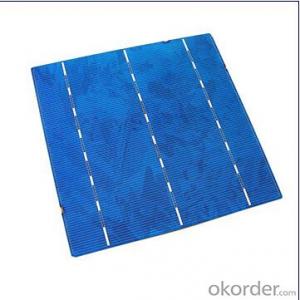High Quality 17.2% Polycrystalline Solar Cells for Space Applications
- Loading Port:
- Shanghai
- Payment Terms:
- TT OR LC
- Min Order Qty:
- 1000 pc
- Supply Capability:
- 1000000 pc/month
OKorder Service Pledge
OKorder Financial Service
You Might Also Like
Solar Cells:
solar cells, when struck by photons of light from the sun, generates an electrical current which can then be used to power DC or AC electrical loads.
A solar cell is made of silicon. Computer chips are made of this same material. Basically, when light strikes the surface of a solar cell some of it is absorbed into the silicon. This light energy bumps the electrons loose and causes energy to flow
Solar cells is made by solar wafer, it has three categories of solar cell right now, monocrystalline polycrystalline and thin film,These cells are entirely based around the concept of PN junction, which is the critical part of solar module, it is the part that can convert the light energy into electricity, the thickness is from 180um to 200um, with even busbars to conduct electricity, textured cell can decrease diffuse reflection; they are often electrically connected and encapsulated as a module. Photovoltaic modules often have a sheet of glass on the front (sun up) side, allowing light to pass while protecting semiconductor wafers from abrasion and impact due to wind-driven debris, rain, hail, etc. Solar cells are also usually connected in series in modules, creating an additive voltage. Connecting cells in parallel will yield a higher current;With high quality and stable quality. Our Cells can greatly improve the performance of Solar Modules.
Features:
High efficiencies up to 16.4%
Proven long term mechanical stability of silicone
Make of highly purified poly silicone
Three bus bars for reduced series resistance and improved module and cell efficiency
Blue anti-reflecting coating ensures improved light absorption and increased efficiency
Acid texturization offers a uniform appearance and virtually invisible crystal structure
Excellent low light behavior for improved energy yield
Specifications
Product Construction: | Epoxy Resin + Cell + PCB |
Maximum Output: | 4w |
Tolerance: | ±3% |
Maximum Output Power (Wmp) | 4w |
Max Working Voltage (Vmp) | 6v |
Max Charging Current (Imp) | 665ma |
Open Circuit Voltage (Voc) | 7.44v |
Short Circuit Current (Isc) | 720ma |
Cell efficiency(η): | 17.2% or above |
PCB | FR-4 |
PCB thickness(mm) | 1.6mm |
PCB color | Black |
PCB size(mm) | 165*165*2.7mm |
Product thickness: | 2.7mm |
Net Weight | 130g |
Barline: | Black tape or none |
Lifetime: | 1-3 years |
Storing temperature | 20°C ~ 60°C |
Working temperature | -20°C ~ 60°C |
Solar Cells Advantage:
1. High efficiency and High power.
2. Long-term electrical stability.
3. Lowest price and Fastest delivery.
4. Good quality and good service.
5.Bulk supply
6. Good Warranty
7.Big Sale
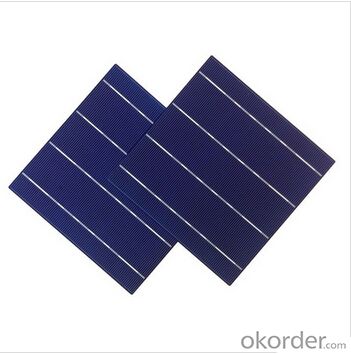
FAQ
We have organized several common questions for our clients,may help you sincerely:
①What price for each watt?
It depends on the efficiency of the solar cell, quantity, delivery date and payment terms.
②How long can we receive the product after purchase?
In the purchase of product within three working days, We will arrange the factory delivery as soon as possible. The pecific time of receiving is related to the state and position of customers.Commonly 7 to 10 working days can be served.
③Can you provide the peripheral products of the solar panels, such as the battery, controller, and inverter? If so, can you tell me how do they match each other?
Yes, we can, we have two companies for solar region, one is CNBM International, the other is CNBM engineering Co.
We can provide you not only the solar module but also the off grid solar system, we can also provide you service with on grid plant.
④What is your warranty of solar cell?
Our product can promise lower than 0.3% open box crack, we support claim after opening the box if it has crackm color difference or sth, the buyer should give pictures immediately, we can not accept the claim after the solar cell has assembled to solar panel.
• Timeliness of delivery
• ⑤How do you pack your products?
We have rich experience on how to pack the solar cell to make sure the safety on shipment, we could use wooden box or pallet as buyer's preference.
- Q: Can solar cells be used in disaster relief or emergency response situations?
- Yes, solar cells can be used in disaster relief or emergency response situations. They provide a reliable and sustainable source of electricity, especially in areas where the power grid has been disrupted or damaged. Solar cells can be used to power communication systems, emergency lighting, medical equipment, and water purification systems, among others. Their portability and ease of installation make them an ideal solution in such situations, ensuring that critical services and infrastructure can continue to function even during emergencies.
- Q: Monocrystalline silicon and polycrystalline silicon cell in the appearance of what is the difference?
- There is a part of the area filled with dissatisfaction, and polysilicon solar cells are square, there is no such problem, so the efficiency of the solar cell components is almost the same. In addition, due to the two solar cell materials manufacturing process is not the same, polysilicon solar cell manufacturing process consumption of energy than monocrystalline silicon solar cells about 30%, so polysilicon solar cells
- Q: What is the future of solar cell technology?
- The future of solar cell technology looks promising as advancements continue to be made in efficiency, flexibility, and affordability. With ongoing research and development, we can expect to see solar cells becoming more efficient in converting sunlight into electricity. Additionally, innovative designs such as transparent solar cells and solar-powered windows are being explored, expanding the possibilities for integration into everyday objects and infrastructure. As costs continue to decrease, solar energy will likely become more accessible and widespread, contributing to a cleaner and more sustainable future.
- Q: What is the impact of algae growth on solar cell performance?
- The impact of algae growth on solar cell performance is generally negative. Algae growth on the surface of solar cells can reduce their efficiency by blocking sunlight and causing shading. This reduces the amount of light that reaches the solar cells, thereby reducing their power output. Additionally, algae can also produce a biofilm that affects the surface properties of the solar cells, leading to further degradation in performance over time. Therefore, it is important to regularly clean and maintain solar panels to minimize the negative effects of algae growth.
- Q: Can solar cells be used for disaster relief efforts?
- Yes, solar cells can be used for disaster relief efforts. They provide a reliable source of clean energy, which can be crucial in situations where traditional power sources are disrupted or unavailable. Solar cells can be used to power emergency communication systems, medical equipment, lighting, and water purification systems, among other essential needs in disaster-stricken areas. Additionally, portable solar panels can be easily deployed to remote locations, making them an ideal solution for providing immediate power during relief operations.
- Q: Are bulk solar cells better than the normal solar cells?
- On average, normal solar cells can not provide as much energy compared to bulk solar cells, however, if we change the material into silicon, it would.
- Q: What is the history of solar cell development?
- The history of solar cell development dates back to the 19th century when the photovoltaic effect was first discovered by French physicist Alexandre-Edmond Becquerel in 1839. However, it wasn't until 1954 that the first practical silicon solar cell was developed by Bell Labs scientists. This breakthrough led to the commercialization of solar cells and their initial use in space applications, such as powering satellites. Throughout the 1960s and 1970s, solar cell technology continued to advance, primarily driven by research and development efforts in the United States. The energy crisis of the 1970s further fueled interest in renewable energy, including solar cells, leading to increased investment and technological advancements. In the 1980s and 1990s, solar cells became more efficient and affordable, making them increasingly popular for off-grid applications, such as powering remote locations and providing electricity to rural communities. Governments and organizations worldwide started implementing policies and incentives to promote solar energy adoption. In the early 2000s, there was a significant growth in the solar industry, driven by technological improvements, increased manufacturing scale, and declining production costs. This led to the widespread adoption of solar panels for residential and commercial use, as well as grid-connected solar power plants. Today, solar cells continue to evolve, with ongoing research focused on improving efficiency, durability, and reducing costs. The integration of solar cells into various applications, such as building materials and consumer electronics, further expands their potential. The solar industry plays a crucial role in the global shift towards clean and sustainable energy sources.
- Q: What is the typical warranty for solar cells?
- The typical warranty for solar cells usually ranges from 10 to 25 years.
- Q: Can solar cells be used in off-grid applications?
- Yes, solar cells can definitely be used in off-grid applications. Off-grid systems rely on renewable energy sources like solar power to generate electricity independently from the main power grid. Solar cells, also known as photovoltaic cells, convert sunlight directly into electricity and can be used to power various off-grid applications such as remote cabins, boats, or even outdoor lighting systems. The ability of solar cells to operate without the need for a connected power grid makes them ideal for off-grid scenarios where access to electricity is limited or unreliable.
- Q: Can solar cells be used to power cars?
- Yes, solar cells can be used to power cars. Solar-powered cars utilize photovoltaic cells to convert sunlight into electricity, which can then be used to power the vehicle's electric motor. While solar-powered cars are still in development and face challenges such as limited energy storage and efficiency, they hold potential for reducing reliance on fossil fuels and minimizing greenhouse gas emissions.
Send your message to us
High Quality 17.2% Polycrystalline Solar Cells for Space Applications
- Loading Port:
- Shanghai
- Payment Terms:
- TT OR LC
- Min Order Qty:
- 1000 pc
- Supply Capability:
- 1000000 pc/month
OKorder Service Pledge
OKorder Financial Service
Similar products
Hot products
Hot Searches
Related keywords
